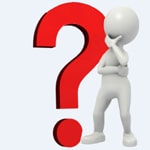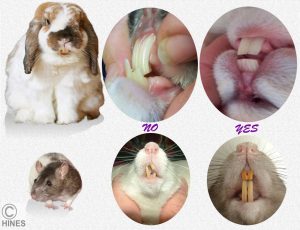 Rodent And Rabbit Tooth Problems And How I Treat Them
Rodent And Rabbit Tooth Problems And How I Treat Them
Ron Hines DVM PhD

I see misaligned, overgrown tooth problems most frequently in rabbits – but any rodent is susceptible to them. Rabbits – which are actually lagomorphs and not true rodents – as well as the rest of the rodent clan, are unique among mammals in that their teeth grow for the duration of their lives. Teeth are the most important part of a grass-eating animal. Elephants are born with four sets of them. Horses and camels have long tooth shafts embedded below the gums that continue to move upward throughout life. But rabbits and rodents are the only animals I know of whose teeth are open-rooted and continue to grow throughout their lives. In the wild, where genetics, calcium levels, and constant gnawing occur – the teeth rarely give bunny problems. But in a house-rabbit- setting, teeth can become a life-threatening problem. Proper wear of teeth depends on exact alignment of upper and lower jaws. If the upper and lower incisors (front teeth) are misaligned even one millimeter in immature bunnies, the problem will exacerbate as the animal matures because these teeth grow three to five inches a year! . Soon thee molar or cheek teeth become affected due to lack of grinding contact. It can take six months to over a year for you to notice a problem. The scientific name for this problem is malocclusion it’s also called “slobbers”, “wolf” “Scissor toothed” or “buck toothed”. It also mysteriously commonly occurs suddenly in older rabbits. The cause of this is unknown, but could include improper calcium/phosphorous diet ratio, broken molar teeth on the opposite side, kidney disease, and the fact that pet bunnies live so much longer now.
The rabbits begin to drool and assume an open-mouthed, startled expression. A wet chin and dewlap are common. If incisor misalignment is caught very early, and treated with proper dental instruments rather than just breaking the teeth off, the problem can often be corrected for the rest of the bunnies life by slightly overcompensating the angle of the misaligned teeth in the opposite direction. It may take several attempts ant 3-4 month’s intervals to accomplish this. Under no circumstances (short of saving a weakened rabbit’s life), should the teeth be clipped with shears or pliers. The teeth have the consistency of glass and shatter – often below the gum line. Some veterinarians and most dentists have the equipment and expertise to smoothly cut the teeth into proper alignment. If the problem is not corrected, the Rabbit looses weight and mouth infections and abscesses occur. Despite my reluctance to administer antibiotics to rabbits, in severe cases it may be required – Particularly when the lower and upper molar teeth have penetrated the opposing gums.
Thoughts differ on the use of general anesthetics for this procedure. When they are used, the dangers of the anesthetics far outweigh the dangers of the procedure. The temperament of the individual rabbit is most important, as are the specific teeth involved.
Gas anesthetics require a tube in the mouth that obstructs view. When it is necessary, I prefer a very light dose of dissociative anesthetic or “tranquilizer” – one that make the bunny unaware of what is occurring but does not affect respiration. I do not suppose any two veterinarians or dentists use exactly the same techniques – so do not worry if advice differs. I prefer the use of post-operative oral disinfectants to antibiotics because of safety issues.
I prefer not to extract teeth unless they are abscessed and devitalized. The bone between the tooth root and the nasal turbinates (spiral passages) is tissue paper thin. I have seen several bunnies and squirrels that have had their incisors extracted and then developed nasal problems. Rabbits and rodents love to gnaw and I find it cruel to deprive them of this activity unless absolutely necessary. Not everyone needs a veterinarian or dentist to correct minor problems. I have four instruments I use for this procedure: A Bell International Medical Hand engine #1670, a Duro 6014470 grinder (no longer available) and a Handi Works Rotary Tool MHW550 (which cost the least and I like the best). Adapter collets are available at Wat-Mart. I purchase my mandrels and Aluminum Oxide cutting discs from Henry Schein Inc. (Faskut 8 7/8”x0.025, Dentsply, York PA and Faskut Mandrel #989001 respectively) . It cuts the teeth off perfectly. I saw similar aluminum oxide Dremel™ accessories at Wall-Mart last month but I have not tried them. . I try to get the bunny used to the wine of the motor and have it steadily restrained in a wrapped beach towel by one person and another person with a steady hand (me) , wearing glasses, and his elbow steadying him on the counter makes the cut. Be sure to grasp the cut off teeth with a forceps before the rabbit swallows them! Dip the edge of the cutting disc in water from time to time to keep it cool but don’t let the mandrel become wet. The bottom incisor teeth of rabbits are double – so both must be cut off about 1/4 inch above the gum line. If the gums bleed, the teeth were cut too short. I have seen quite a few rabbits and guinea pigs and rats that not only had curling incisors (front teeth) but also curling molars (back teeth). This week, I had a 100 lb capybara come in with the same problem. If the rabbit still can’t close it’s mouth and has a kind of gaping expression after the incisors are fixed, one needs to examine the molars too. I do this with a Popsicle stick, nasal speculum, or, when I’m in a brave mood, do it with my little finger. If these back teeth are overgrown they are much harder to cut and the buccal (outer) edge of the tooth can be razor-sharp. . To correct these requires a medical instrument called a bone rongeur and dental files. Because it is quite uncomfortable to the bunny it is best done at a veterinarian’s office under a little dissociative anesthetic (or gas). The bone between the tooth root and the nasal turbinates (passages) is tissue paper thin. I have seen several bunnies and squirrels that have had their incisors extracted and then developed nasal problems.
Be sure to keep chew toys available for all your bunnies and rodents. For my personal bunnies, and agoutis, my favorite, it’s the base of deer and elk antlers or a cement parrot perch, with creamy peanut butter rubbed into it. Next best, I like hard-rock maple dowels and squares hanging from cords. Floor-grade, unvarnished red oak scraps are extremely hard and easily available – the wood is said to contain tannins that can be harmful to rodents but I have never seen problems that could be attributed to this. Any lumber that is greenish (impregnated with arsenic and salt) should not be used.
If your breeder pairs consistently produce litters with this problem, your calcium/vitamin D ratios in the diets are off or they are genetically predisposed to the problem. It is also thought that tooth or jaw trauma in the pups can misalign the teeth.



 Rodent And Rabbit Tooth Problems And How I Treat Them
Rodent And Rabbit Tooth Problems And How I Treat Them